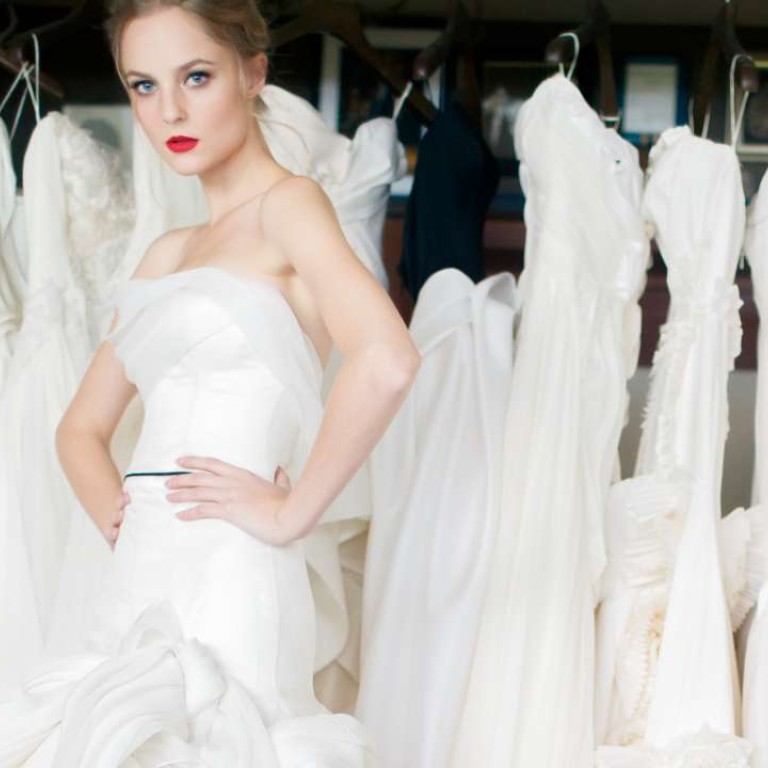Wedding gowns should be made by a designer who can be trusted, say brides

Whether a bride opts to adapt an existing design or create something entirely new, most designers suggest they start about six months before their wedding
From bridal boutiques and chain stores to sample sales and rental services, brides are spoiled for choice when it comes to finding the perfect wedding gown. But for many women, nothing compares to a gown that is made specifically for them and that reflects their personality.
“I thought it would be easier to buy a dress in Singapore,” says Claudia Yong, who moved from Hong Kong to Singapore before her wedding last year. “I went to two or three stores. But there’s always some element about a dress that you might not like or you think should fit differently. It’s a huge amount of money so I thought, ‘If I’m going to pay that much, why wouldn’t I get a dress that’s really made for me’?”
Yong ended up enlisting the services of Hong Kong bridal designer Vivian Luk, who had designed gowns for two of Yong’s best friends. A graduate of Parsons School of Design and the Fashion Institute of Technology in New York, Luk worked for celebrity bridal designer Vera Wang before setting up her own atelier in Happy Valley in 2008.
She is one of a handful of local designers offering bespoke wedding gowns, including Noel Chu,Dorian Ho and Cecilia Yau, among the many international fashion houses offering customised and fully custom-made gowns.
Whether a bride opts to adapt an existing design or create something entirely new, most designers suggest they start about six months before their wedding. “We always recommend around six to nine months in advance, so the bride can have enough time to decide, have her fittings and change any detail of the dress,” says Hervé Moreau, creative director of Pronovias, a Barcelona-based fashion group specialising in bridal and evening wear. “We have to take into account that a dress could have up to 800 different pieces and could take between 80 and 200 hours to complete.”
Luk, who sometimes meets brides a year before their wedding, advises against starting too early: “You need to find the middle ground. If it’s too long, the bride changes her mind, her body changes, trends change.
So I try to start six months in advance.”
I think it’s important for a designer to know what they’re good at, and not be promising the world. But even within my style, I try to say you can pretty much do anything
Once a bride decides she wants a bespoke gown, the first and perhaps most important step is choosing a designer. “The thing about custom is you need to trust your designer. With off-the-rack, you can already see it and envision it. But with a custom-made dress, you’re thinking, ‘Oh no, it’s two months to my wedding and I haven’t seen the end product. Am I going to be okay with it’?” Yong says. “You need to choose someone you like and someone you trust.”
Luk – who is known for her use of lace, draping and colour – says most clients find her through word of mouth and seek her out because of her signature style. “I think it’s important for a designer to know what they’re good at, and not be promising the world,” she says. “But even within my style, I try to say you can pretty much do anything. Because with bespoke, you’re really starting from zero.”
Then begins the process of determining the bride’s particular style, what kind of statement she wants to make, and how it all fits with everything from her wedding flowers and colour theme to venue and lighting. “You need to talk to them from the get-go,” says Luk, who invites prospective clients to her atelier to try on a range of styles and silhouettes, and takes photos to discuss over WhatsApp later. “You have to ask a lot of questions. Because even though all brides are different, there are similar questions you can ask them that they are probably asking themselves.”
Pronovias produces about 50 designs each year for its haute couture collection, Atelier Pronovias, from which clients can select a base and then change sleeves, fabrics or decoration or combine elements of different dresses into one. “We try to help the bride to not be worried about the dress; it’s the last thing she should be worried about,” Moreau says. “We try to imagine all the feelings and emotions that will surround her that day, and we just want her to look comfortable and of course beautiful at all times.”
Luk, whose atelier typically works on six to 10 bespoke dresses at one time, emphasises the importance of the experience from the initial meetings to the fitting of the bustier, base and draping to putting the entire look together with hair, make-up and accessories. It’s also about the collaboration between bride and designer, and in some cases the time shared with loved ones who attend the fittings.
“There were numerous emails, dialogue and fittings, and during all this there was an exchange of ideas. It was direct input from me and direct input from Vivian,” says Secy Chin, who commissioned Luk to design three dresses for her wedding. “I saw how our ideas were coming together and how our designs evolved. My gowns are not just my gowns; I really believe they are art pieces – art pieces which have souls. They have all my sweet memories and all the little stories that form a part of me. This is what I call a truly one-of-a-kind experience.”